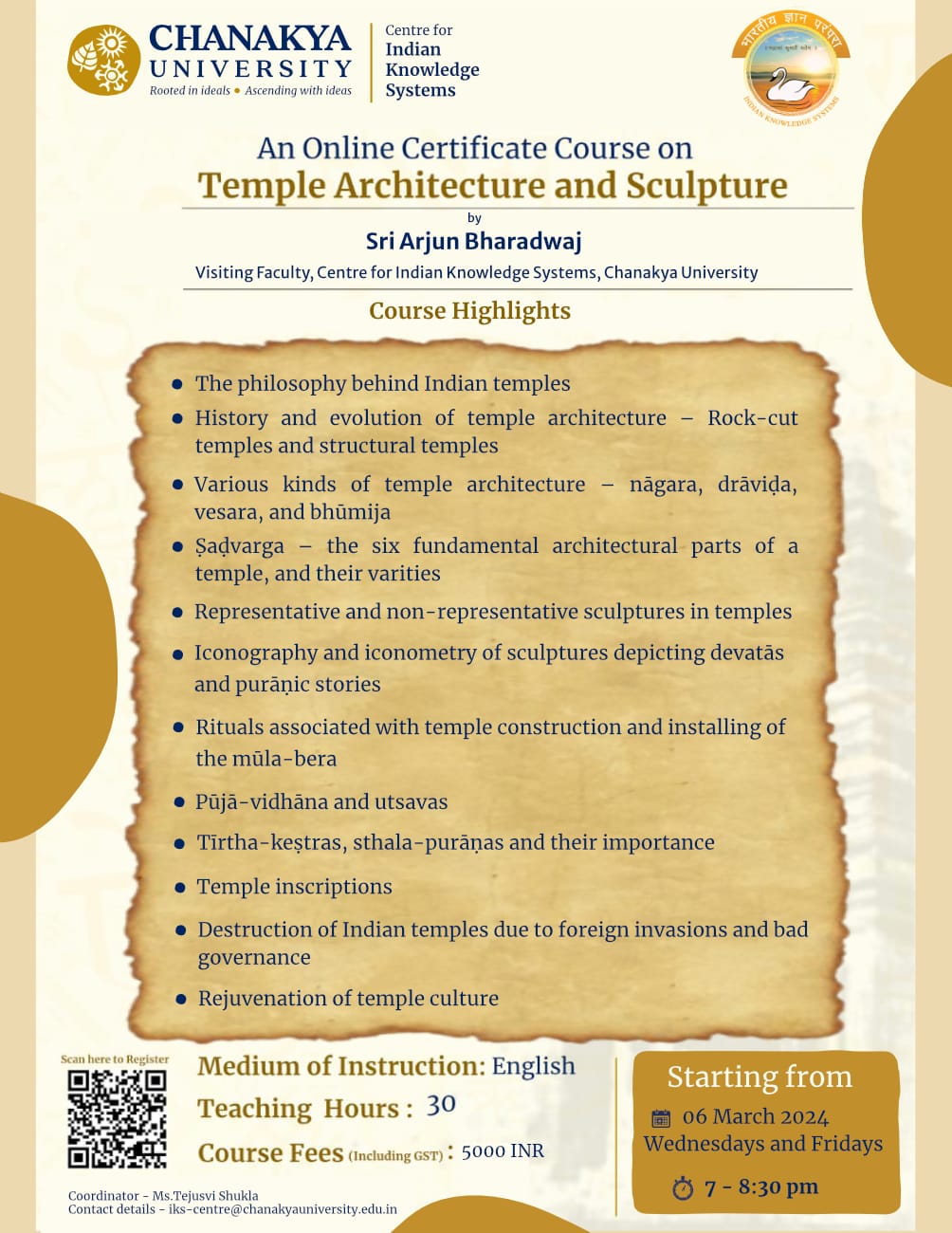Appreciating Temple Architecture and Sculpture

Course Title: Appreciating Temple Architecture and Sculpture
Faculty: Sri. Arjun Bharadwaj, Visiting Faculty, Centre for Indian Knowledge Systems, Chanakya University, Bengaluru.
Prologue:
The Sanātana-Devālaya, i.e., the Indian Temple, in its essence, is a microscopic representation of the macrocosm. It embodies and houses the saguṇa-brahma, i.e., the deity in worship. The roots of the devālaya (popularly translated as ‘temple’), lie in the vedic traditions – the temporary yajña-śālā and the yajña-vedi of the vedic period metamorphosed into permanent structures built out of stone, brick and wood in the later days. The pūjā that is performed in the temple also finds its roots in the vedic ritual.
Temples form the nucleus of the Indian civilization. Until the recent past, there was hardly any activity of the Indians which was not centred around a temple. A temple functioned as a place of worship, centre of education, seat of justice, hospital, fortress, melting pot of different art forms, financial hub, an institution of tangible historical documentation, residence for spiritual seekers and much more. It catered to the intellectual, artistic, emotional and spiritual needs of the Indian. Even the smallest of the shrines had one or more of these dimensions. The temple provided employment to people of all sections of the society during its construction and also for its functioning.
Introduction to the course:
The current course aims to introduce the audience to various aspects connected with the Indian temples. In addition to providing a historical perspective of the evolution of temple architecture, the course also covers the various styles of architecture present around the country, the process and rituals associated with the construction, and the philosophy behind the structure of a temple. The course also sheds light upon temple sculptures, including their features of iconography and iconometry. The different kinds of pūjās and utsavas associated with temples will also be covered. Temples that are a part of the Akhaṇḍa-bhārata, i.e., those that are present outside the political borders of India in countries such as Thailand, Cambodia, Indonesia, and Vietnam will be discussed as well. The course will also throw light on the various destructive forces that have been responsible for the degradation of the temple culture and attempts to provide ideas for rejuvenating the glory of the Indian temple traditions, in places where it is lost.
Objectives:
- Understanding the importance of the Indian Temples as the nucleus and the heart of the Indian civilization.
- Appreciating the science and philosophy behind different kinds of temple architecture and sculptures
- Inspiring the participant to rejuvenate temple culture in places where it is lost.
Topics covered:
- The philosophy behind Indian temples
- History and evolution of temple architecture – Rock-cut temples and structural temples
- Various kinds of temple architecture – nāgara, drāviḍa, vesara, and bhūmija
- ṣaḍvarga – the six fundamental architectural parts of a temple, and their varities
- Representative and non-representative sculptures in temples
- Iconography and iconometry of sculptures depicting devatās and purāṇic stories
- Rituals associated with temple construction and installing of the mūla-bera
- Pūjā-vidhāna and utsavas
- Tīrtha-keṣtras, sthala-purāṇas and their importance
- Temple inscriptions
- Destruction of Indian temples due to foreign invasions and bad governance
- Rejuvenation of temple culture
| Teaching Hours | 30 |
| Starting from | 06.03.2023, Wednesday |
| Timings | 7–8.30 pm, Wednesdays and Fridays (recordings will be made available) |
| Medium of Instruction | English |
| Course Fees (including GST) | 5,000/- INR |
